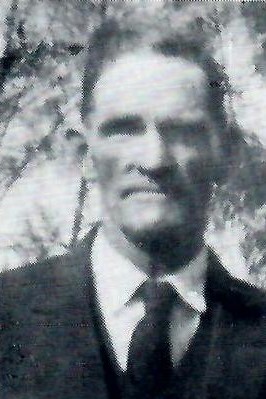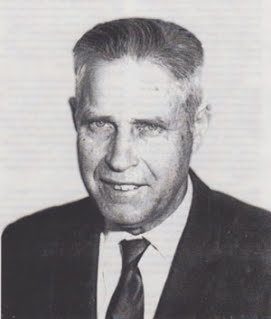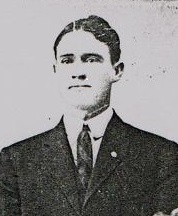ROBERT CHESTNUT BEECROFT
(1873-1958)
Robert Chestnut Beecroft was born in Holden, Millard County, Utah, July 15, 1873. He was the son of John Hurst and Ellen Chestnut Beecroft.
December 24, 1889 he arrived with his parents in Colonia Juarez, Chihuahua, Mexico. There he remained with his uncle, Henry Chestnut, who was night-watchman at the Henry Eyring store, until March 1890, when he moved on to Colonia Pacheco.
In Pacheco, he went to work at a sawmill, first for Al Farnsworth and later for John Campbell. He dearly loved the people of Pacheco. The memory of friendships with such men as John E. and Walter H. Steiner and William and David P. Black were cherished memories all of his life.
There in Pacheco Robert Chestnut Beecroft met Lilly Marinda Rowley. They were married April 14, 1894. To them were born a boy, Nello Robert, August 11, 1896 and a girl, Emma, January 4, 1898.
Besides working at sawmills, “Rob” did freighting.
In March 1898 he moved his family to Colonia Oaxaca, Sonora, Mexico. There, two girls were born to them, Lilly Mae, September 30, 1899, and Ellen, July 27, 1902.
Rob carried on as a freighter, hauling ore from the El Tigre mine, near Colonia Oaxaca to Nuevo Casas Grandes, Chihuahua, Mexico. The road he traveled over was truly a pioneer road. The treacherous Bavispe River had to be crossed. The Pulpit Canyon road was next to impassable. It was solid rock for miles and in places it was like a staircase.
At one point called “The Squeeze” it was so narrow that a wagon could barely pass through. There were drops from ledge to ledge to ledge; the wagon tongue would knock the horses from side to side, even knocking them down at times. His own words tell it thus:
I made my living freighting, driving six to eight horses on one line and three wagons. The mountain roads were so rough that could only take one wagon at a time, taking it to the top of the mountain, leaving it, and going back after the next. After getting the last wagon to the top, I would put the ore all in one wagon. The trip was then made the rest of the way to Nuevo Casas Grandes. The ore was then loaded on the train and taken to El Paso, Texas to the smelters.
In Colonia Oaxaca, Rob built a brick house for his family. Later a flood came down the Bavispe River, washed sixteen houses away and took the roof of his new brick home.
His wife Lilly died in 1904, so he moved back to Pacheco with his young children. His brother John took Nello and Emma to Colonia Garcia. Mae went to live with Lilly’s sister, Ozella Rowley. Ellen went to another sister of Lilly’s, Orissa Rowley, while Rob continued freighting.
There in Pacheco he met and married Nancy Erina Buchanan, October 18, 1905. At this time, Robert had acquired some farm land and farmed in season. He also worked on adjoining sawmills, being fireman and engineer.
December 3, 1906 they had a son born, William Elvin.
Rob said:
In 1908 I was called to go on a two year mission in Mexico. I took my wife and baby with me to Salt Lake City. There we were sealed. Then we took the train back to El Paso. We had to walk across the bridge crossing the Rio Grande River which separates the USA and Mexico. Edna and the baby took a train for the colonies which was the way back home for them, while I took another train for Mexico City and my mission, where I labored for a little over two years. I arrived back home Christmas Eve 1910. While on my mission in Mexico State I was living at Ozumba. I presided over eight different branches. Rey L. Pratt was President over the Mexican Mission, with Will Jones as first counselor and myself as second counselor.
While laboring there I was fined for not paying taxes on my wages. We were in court two days. The judge said either my church paid me or the people over whom I presided paid me. I told him that neither of them did, but that I paid my own way. I appealed to Chalco, and the officers at Chalco appealed to the state capitol. But I never did hear from them again.
His mission being ended, he took a train for home, arriving at the nearest railroad station in Pearson, Chihuahua, near Colonia Juarez where his wife Edna awaited him. His son Nello met him at Pearson with horses. “Horseback” they returned to Pacheco arriving Christmas Eve, 1910. For the first time he saw his daughter Marva, who was born four months after he left for his mission. She was born February 17, 1909.
Again in Rob’s own words:
Back to work again, sawmilling. We moved to Cumbre sawmill working for Lester Farnsworth and John Whetten. They had acontract to build a bridge which was the highest bridge in America,being 800 feet high, and took one million feet of timber. At Cumbre was a tunnel that was three-quarters of a mile long which the train went through.
October 5, 1911 a baby boy was born to us, Carl J.
In 1912, because of the Mexican Revolution, we were told to leave Mexico. In August of that year we put our women and children on the train and sent them to El Paso. All men over fifty years of age, and boys under sixteen years had to go with the women. All boys over sixteen had to stay with the men. So my son Nello stayed with me, as he had just turned sixteen August 11.
Early the next morning, the train left Pearson for El Paso, Texas, USA, while we men and boys headed back to the mountains and our homes and our crops.
I had to stay to a meeting in Colonia Juarez, at President Bentley’s place, and before I got back to my home at Pacheco, which was thirty-five miles from Colonia Juarez, our Bishop met me and sent me through the hills, away from the road to Colonia Garcia as a runner, to tell the Garcia men to meet with the Pacheco men at a certain place in the mountains. Then the valley men were to meet us and all head for the USA together. In our travel overland, Bishop A.D. Thurber was chosen captain. He chose Lester B. Farnsworth as first assistant and Robert C. Beecroft as second assistant of the company, which consisted of 240 men.
The night we left our homes at Pacheco the Mexicans set fire to the town, burning all the lumber houses.
Our daughter Valoise was born August 6, 1915 at St. Johns, Arizona.
I went back to Mexico because our land and everything we owned was there. In our company going back was myself and family, brother John and family, Frank 0’Donnal and family, John and Bert Whetten and their families.
We landed at Colonia Dublan. I was the night watchman at the Farnsworth and Romney store for about one year. I then hired a 200 acre farm. Our crops were alfalfa, wheat, and beans. I farmed there for a number of years.
We had another daughter Ethel born January 22, 1922 in Colonia Garcia.
While working with Lester B. Farnsworth in 1922 at Garcia he acquired 140 head of cattle. The men of the town of Garcia together purchased the Jacobson cattle, with the UT brand. These cattle were located on the ranch near the Dublan Lakes. They were paid for with lumber from the Garcia mill. Later he moved these cattle to the North Valley Ranch near Chuhuichupa, where he also moved his family. There he also farmed, raising corn, oats and potatoes.
February 18, 1925 a daughter, Maurene, was born in Chuhuichupa.
In the autumn of 1926, because of illness of his daugher Ethel, he and Edna with their family moved to Douglas, Arizona to give medical care to
Ethel.
Douglas was born while there, February 18, 1927.
In 1928, Rob sold his cattle that he had on the North Valley Ranch. He invested the money with the Farnsworth and Romney Mercantile Company. They owned a store in Sabinal, a rich silver mine on the Corralitos Ranch. They sent Robert there to run the store. His family was in Colonia Juarez where Elvin, Marva and Carl were enrolled in the Juarez Stake Academy.
Later Rob was transferred to the store in Juarez, owned by the same Mercantile Company.
In 1931 he sold his equity in the Mercantile business for cattle. He moved his cattle and his family back to Chuhuichupa.
In 1932 he rented his cattle out and moved to Mesa, Arizona. Later he sold his cattle and bought a home near the Arizona Temple in Mesa.
Robert passed away October 2, 1958 at his home, 240 Wood Lane, Mesa, Arizona.
Ellen Beecroft Farnsworth, daughter
Stalwarts South of the Border,
Nelle Spilsbury Hatch pg 27



